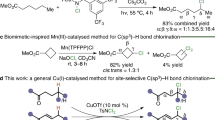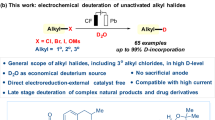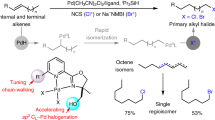Abstract
THE ease with which hydrogen chloride can be removed from simple aliphatic chloro-compounds by the action of alcoholic caustic alkali has been recognized for many years. It is also possible to split off hydrogen chloride from these compounds by contact catalysis, or simply by pyrolysis, and there are many patents covering these processes.
This is a preview of subscription content, access via your institution
Access options
Subscribe to this journal
Receive 51 print issues and online access
$199.00 per year
only $3.90 per issue
Buy this article
- Purchase on Springer Link
- Instant access to full article PDF
Prices may be subject to local taxes which are calculated during checkout
Similar content being viewed by others
References
Kaplan, Grishin and Skvortsova, J. Gen. Chem. (U.S.S.R.), 7, 538 (1937).
Hinshelwood, "The Kinetics of Chemical Change", 244.
J. Chem. Phys., 4, 732 (1936).
Author information
Authors and Affiliations
Rights and permissions
About this article
Cite this article
BARTON, D. Induced Dehydrochlorination of Substituted Ethanes. Nature 157, 626–627 (1946). https://doi.org/10.1038/157626b0
Issue Date:
DOI: https://doi.org/10.1038/157626b0
Comments
By submitting a comment you agree to abide by our Terms and Community Guidelines. If you find something abusive or that does not comply with our terms or guidelines please flag it as inappropriate.



